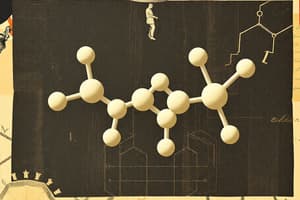Podcast
Questions and Answers
Every cyclic group is abelian
Every cyclic group is abelian
True (A)
Rational numbers under addition is a cyclic group
Rational numbers under addition is a cyclic group
False (B)
All generators of Z20 are prime numbers
All generators of Z20 are prime numbers
False (B)
Any two groups of order 3 are isomorphic
Any two groups of order 3 are isomorphic
Every isomorphism is a one-to-one function
Every isomorphism is a one-to-one function
An additive group cannot be isomorphic to a multiplicative group
An additive group cannot be isomorphic to a multiplicative group
Groups of finite order must be used when forming an internal direct product
Groups of finite order must be used when forming an internal direct product
Z2 X Z4 is isomorphic to Z8
Z2 X Z4 is isomorphic to Z8
Every subgroup of every group has left cosets
Every subgroup of every group has left cosets
One cannot have left cosets of a finite subgroup of an infinite group
One cannot have left cosets of a finite subgroup of an infinite group
A subgroup of a group is a left coset of itself
A subgroup of a group is a left coset of itself
Only subgroups of finite order have left cosets
Only subgroups of finite order have left cosets
A binary operation * on a set S is commutative if there exist a, b in S such that ab = ba
A binary operation * on a set S is commutative if there exist a, b in S such that ab = ba
Every binary operation on a set having exactly one element is both commutative and associative.
Every binary operation on a set having exactly one element is both commutative and associative.
A binary operation on a set S may assign more than one element of S to some ordered pair of elements S
A binary operation on a set S may assign more than one element of S to some ordered pair of elements S
Any two groups of three elements are isomorphic
Any two groups of three elements are isomorphic
In any group, each linear equation has a solution
In any group, each linear equation has a solution
Every finite group of at most four elements is abelian
Every finite group of at most four elements is abelian
Every group has exactly two improper subgroups
Every group has exactly two improper subgroups
Z4 is a cyclic group
Z4 is a cyclic group
Every function is a permutation if and only if it is one to one and onto.
Every function is a permutation if and only if it is one to one and onto.
Every subgroup of an abelian group is abelian
Every subgroup of an abelian group is abelian
Every subgroup of a non-abelian group is non-abelian
Every subgroup of a non-abelian group is non-abelian
Every permutation can be written as a cycle
Every permutation can be written as a cycle
A group may have more than one identity element.
A group may have more than one identity element.
In each group, each linear equation has a solution.
In each group, each linear equation has a solution.
The proper attitude toward a definition is to memorize it so that you can reproduce it word for word.
The proper attitude toward a definition is to memorize it so that you can reproduce it word for word.
Any definition a person gives for a group is correct provided that everything that is a group by that person's definition is a group.
Any definition a person gives for a group is correct provided that everything that is a group by that person's definition is a group.
Any definition a person gives for a group is correct provided he or she can show that everything that satisfies the definition is a group.
Any definition a person gives for a group is correct provided he or she can show that everything that satisfies the definition is a group.
Every finite group of at most three elements is abelian.
Every finite group of at most three elements is abelian.
An equation of the form axb=c always has a unique solution in a group.
An equation of the form axb=c always has a unique solution in a group.
The empty set can be considered a group.
The empty set can be considered a group.
The associative law holds in every group.
The associative law holds in every group.
There may be a group in which the cancellation law fails.
There may be a group in which the cancellation law fails.
Every group is a subgroup of itself.
Every group is a subgroup of itself.
In every cyclic group, every element is a generator.
In every cyclic group, every element is a generator.
Every set of numbers that is a group under addition is also a group under multiplication.
Every set of numbers that is a group under addition is also a group under multiplication.
A subgroup may be defined as a subset of a group.
A subgroup may be defined as a subset of a group.
Every subset of every group is a subgroup under the induced operation.
Every subset of every group is a subgroup under the induced operation.
Every permutation is a one-to-one function.
Every permutation is a one-to-one function.
Every function is a permutation if and only if it is one to one.
Every function is a permutation if and only if it is one to one.
Every function from a finite set onto itself must be one to one.
Every function from a finite set onto itself must be one to one.
Every finite group contains an element of every order that divides the order of the group.
Every finite group contains an element of every order that divides the order of the group.
The theorem of Lagrange is a nice result.
The theorem of Lagrange is a nice result.
Every finite cyclic group contains an element of every order that divides the order of the group.
Every finite cyclic group contains an element of every order that divides the order of the group.
It makes sense to speak of the factor group G/N if and only if N is a normal subgroup of the group G.
It makes sense to speak of the factor group G/N if and only if N is a normal subgroup of the group G.
Every subgroup of an abelian group G is a normal subgroup of G.
Every subgroup of an abelian group G is a normal subgroup of G.
An inner automorphism of an abelian group must be just the identity map.
An inner automorphism of an abelian group must be just the identity map.
S3 is a cyclic group.
S3 is a cyclic group.
Flashcards are hidden until you start studying
Study Notes
Fundamental Group Properties
- Every cyclic group is abelian, meaning the group operation is commutative.
- A subgroup is a left coset of itself; every subgroup of any group has left cosets.
- Finite groups of order less than or equal to 4 are cyclic and consequently abelian.
Group Isomorphisms
- Any two groups of order 3 are isomorphic, due to their equivalent structure.
- All generators of a cyclic group are not necessarily prime numbers; generators can be composite.
- Two finite groups with the same number of elements are not always isomorphic.
- Every isomorphism is a one-to-one function; if a function between groups is oneto-one and onto, then it is an isomorphism.
Cyclic Groups
- A cyclic group of order greater than 2 has at least two distinct generators.
- Every group is isomorphic to some group of permutations, reflecting their structural properties.
Subgroup Properties
- Every subgroup of an abelian group is also abelian.
- A subgroup may exist as a proper subset of a group but does not entail that every subset is a subgroup.
Operations and Structures
- A binary operation on a set can be commutative, but the existence of one pair (a, b) such that ab=ba does not imply the operation is commutative for all elements.
- Each permutation is a one-to-one function but not every function that is one-to-one is a permutation.
Cosets and Ordering
- The number of left cosets of a subgroup divides the order of the group.
- Left cosets of finite subgroups can exist within infinite groups, illustrating that the subgroup's properties extend beyond finite constraints.
Miscellaneous
- The associative law holds in every group, ensuring operations are consistent across group elements.
- An empty set can be considered a group, representing the trivial case of group theory.
- The question of equivalence in groups, such as whether Sn is cyclic for any n, emphasizes the distinct behaviors of permutation groups.
Advanced Concepts
- A structural property of a group must be shared by every isomorphic group, maintaining consistency across group representations.
- Every finite cyclic group contains an element of every order that divides the order of the group.
- Not all groups of prime order are abelian, highlighting exceptions in group structures.
Group/Symmetric Group Relations
- The symmetric group S3 is cyclic, whereas symmetric groups of higher orders may not maintain cyclic structure.
- Groups of prime order cannot serve as the internal direct product of two proper nontrivial subgroups due to their limited structure.
Notes on Automorphisms
- An inner automorphism of an abelian group is the identity map, indicating a lack of structural variations within abelian groups.
Studying That Suits You
Use AI to generate personalized quizzes and flashcards to suit your learning preferences.




